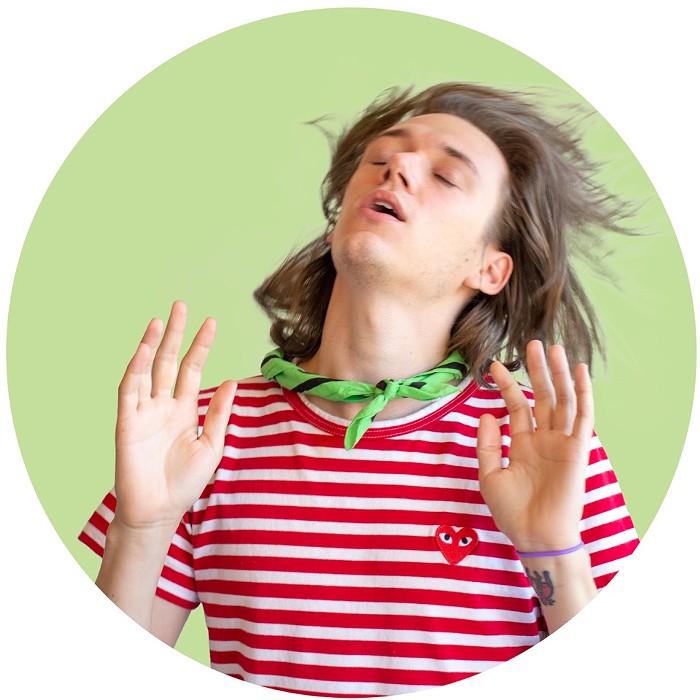
This year's Sundance Film Festival has a bunch of good movies. There's a new Princess Diana doc that uses archival footage to create a dreamy retelling of Diana's life, coming out on HBO Max later this summer. There's also a simple and affecting film about a Black Brazilian family living through the Bolsonaro administration. And then there's Fire of Love, the Miranda July-narrated documentary about two volcanologists in love that National Geographic Documentary Films picked up for an estimated mid-seven-figures.
But it was another Miranda July-narrated film that's stuck with me the most this year.
Filmmaker Matt McCormick's short film the subconscious art of graffiti removal, which screens at Northwest Film Forum this Sunday as part of its Sundance package, is twenty years old, but it took me a second to figure that out. Its topic—graffiti-removal—is as relevant to 2002 as it is to today, as people who closely followed Seattle Mayor Bruce Harrell's mayoral campaign could tell you.
Narrated by Miranda July and inspired by the work of Avalon Kalin, McCormick's film makes the funny argument that graffiti-removal is its own type of "subconscious art," with origins in minimalism and abstract expressionism. The basic idea is that graffiti-removal also becomes a type of art placed on cities, with graffiti "removers" making artistic choices themselves, even if subconsciously.
Kalin started documenting graffiti-removal in the Pacific Northwest in the late '90s after his father noted a lot of graffiti-removal "looked like Rothkos." If you've seen an ugly miscolored rectangle hovering on the side of a building, which you have if you've ever walked around a city, then you know what his dad was talking about.
Conversations about graffiti usually focus on the "taggers" doing the work, and especially how that work relates to anti-graffiti laws and property ownership. During those conversations, people will often bring up (as Bruce Harrell has) that they don't consider graffiti to be art. (People say the same thing about Rothko.) But there's rarely any discussion about the removers who cover up the graffiti. How do we talk about the shapes and scars they also leave on property? Kalin's work is an antidote to that one-sided discussion.
Kalin breaks down graffiti removers' work generally into three categories, which you can read more about in a book published in 2015, available in print and online through Portland State University.
Here are two of those categories, spotted in Seattle this week.
"Conservative" graffiti-removal

Kalin argues that the "standard and most common form" of graffiti-removal, also called masking, is the "conservative" category. This is what you probably think of first when you think of graffiti-removal. A big rectangle that obscures the original tag and maybe tries to match the color of the wall it's covering. These conservative boxes tend to be neutral hues. Beiges. Browns. Grays. Ugly.

The relationship between tagger and remover is an ongoing one. Often, a remover will cover an original tag, only for the tagger to return and tag on top of the remover's masking. This back-and-forth can continue for years, with the remover coming back and using different shades of paint, creating a layered, more colorful image. This can be accidentally beautiful.

Above, a remover has decided to use brown paint on a blue dumpster. Why? How is this an improvement?

"Ghosting"

Kalin refers to another common form of graffiti-removal as "ghosting." Here, a person has only attempted to cover up the lines of the original tag. You can still make out the shape of the original tag, but the ghosting will obscure the tag's content. Kalin writes that this style is often "the result of haste or a lack of resources."

Sometimes ghosting can be exceptionally ugly. Take, for example, the work of the "Ballard Buffer," which The Stranger's Jas Keimig highlights in the video below.
There's a third category, which Kalin calls radical, that occurs when the remover creates an entirely new shape or image on top of the original tag.
"What in a conservative buff might be a rectangle is in the radical buff a rectangle with wheels added to make a truck, line added to imply a gun, or a tail added to imply an animal," says Kalin. "This appears to be some kind of mockery perhaps of the graffiti artist, as an act of some kind of revenge on the part of the remover, perhaps because they own the property and want to rub it in that they have destroyed the tagger's efforts."
I couldn't find any radical examples while walking around the city this week. Seattle's graffiti-removal art is pretty conservative.
As I mentioned earlier, Bruce Harrell, Seattle's new mayor, brings up graffiti-removal all the time.
"I gotta tell ya, what also drives me nuts is this graffiti everywhere," Harrell said during KUOW's Year in Review last December, above. "That is not art. That's graffiti."
In that interview, Harrell suggested some of the city's taggers could be "starving artists... looking for the ability to express themselves." But he emphasized, as he routinely does, that his administration will "clean up this city." He's always making that promise—in November, he told the Seattle Times that he'll "first investigate the culture" of Seattle's taggers and then "try to start a relationship with a lot of these folks.” And then, of course, "clean up" their work.
Harrell's administration is barely a month old and hasn't initiated fresh anti-graffiti enforcement or legislation—but it's clearly coming. And as we wait to see how his administration will paint the city beige or gray, and whether it will do so in blocks or squiggles, Sundance and Northwest Film Forum's revisiting of Kalin's work comes at the best possible time.
You can watch Matt McCormick's short film the subconscious art of graffiti removal alongside three other short films at Northwest Film Forum this Sunday, Jan 30, at 4 PM.













